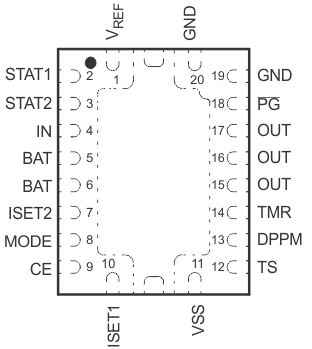SLUS694G March 2006 – December 2014
PRODUCTION DATA.
- 1 Features
- 2 Applications
- 3 Description
- 4 Revision History
- 5 Device Comparison Table
- 6 Pin Configuration and Functions
- 7 Specifications
-
8 Detailed Description
- 8.1 Overview
- 8.2 Functional Block Diagram
- 8.3 Feature Description
- 8.4
Device Functional Modes
- 8.4.1 Sleep Mode - V(IN) < VI(BAT)
- 8.4.2 Standy Mode - V(IN) > VI(BAT)and CE (Chip Enable) Pin = Low
- 8.4.3
Battery Charge Mode - V(IN) > VI(BAT), Battery Present, CE pin = High and DPPM Pin Not Floating
- 8.4.3.1 Automous Power Selection and Boot-Up Sequence
- 8.4.3.2 Charge Control
- 8.4.3.3 Battery Preconditioning
- 8.4.3.4 Battery Charge Current
- 8.4.3.5 Battery Voltage Regulation
- 8.4.3.6 Temperature Regulation and Thermal Protection
- 8.4.3.7 Charge Timer Operation
- 8.4.3.8 Timer Fault Recovery
- 8.4.3.9 Charge Termination and Recharge
- 9 Application and Implementation
- 10Power Supply Recommendations
- 11Layout
- 12Device and Documentation Support
- 13Mechanical, Packaging, and Orderable Information
Package Options
Refer to the PDF data sheet for device specific package drawings
Mechanical Data (Package|Pins)
- RHL|20
Thermal pad, mechanical data (Package|Pins)
- RHL|20
Orderable Information
6 Pin Configuration and Functions
RHL Package
20 Pins
Top View
